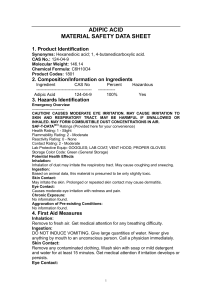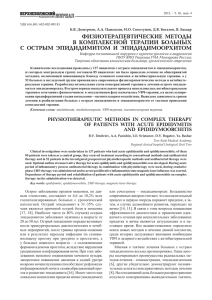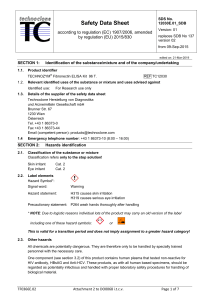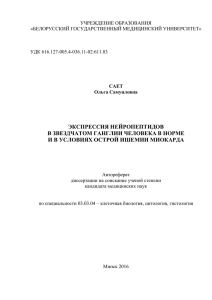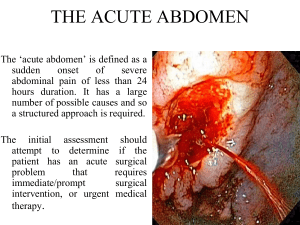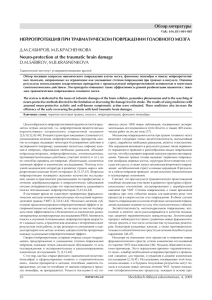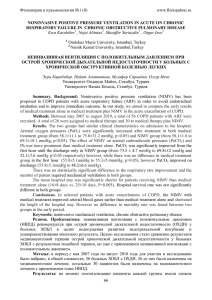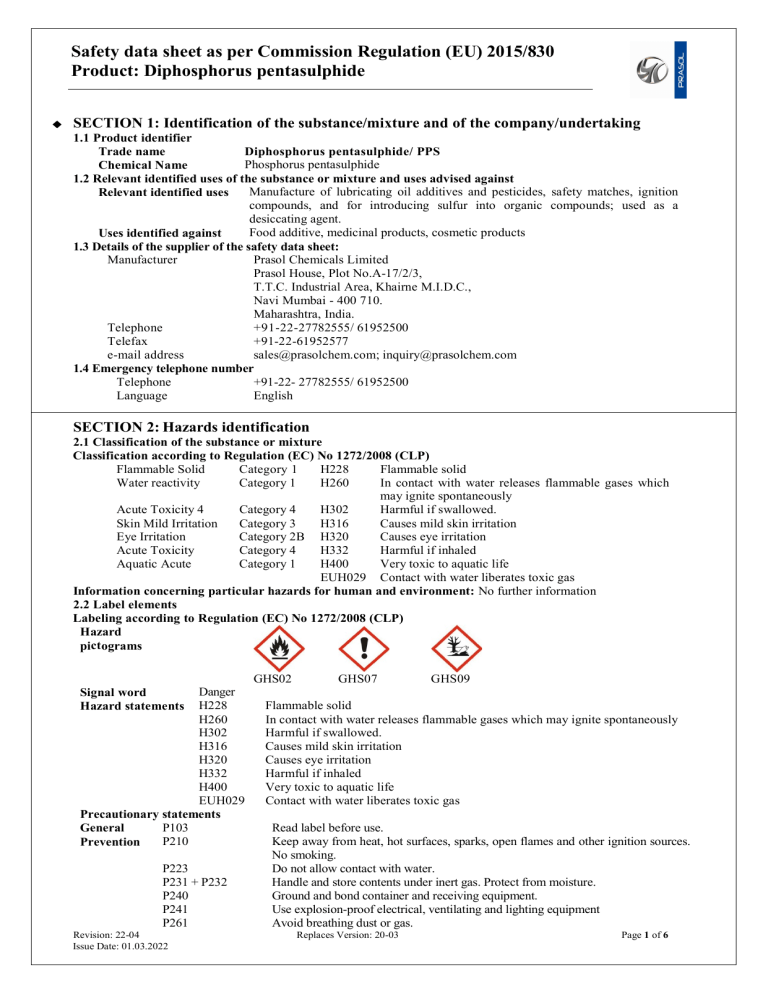
Safety data sheet as per Commission Regulation (EU) 2015/830 Product: Diphosphorus pentasulphide SECTION 1: Identification of the substance/mixture and of the company/undertaking 1.1 Product identifier Trade name Diphosphorus pentasulphide/ PPS Phosphorus pentasulphide Chemical Name 1.2 Relevant identified uses of the substance or mixture and uses advised against Manufacture of lubricating oil additives and pesticides, safety matches, ignition Relevant identified uses compounds, and for introducing sulfur into organic compounds; used as a desiccating agent. Food additive, medicinal products, cosmetic products Uses identified against 1.3 Details of the supplier of the safety data sheet: Manufacturer Prasol Chemicals Limited Prasol House, Plot No.A-17/2/3, T.T.C. Industrial Area, Khairne M.I.D.C., Navi Mumbai - 400 710. Maharashtra, India. Telephone +91-22-27782555/ 61952500 Telefax +91-22-61952577 e-mail address sales@prasolc hem.com; [email protected] 1.4 Emergency telephone number Telephone +91-22- 27782555/ 61952500 Language English SECTION 2: Hazards identification 2.1 Classification of the substance or mixture Classification according to Regulation (EC) No 1272/2008 (CLP) Flammable Solid Category 1 H228 Flammable solid Water reactivity Category 1 H260 In contact with water releases flammable gases which may ignite spontaneously Acute Toxicity 4 Category 4 H302 Harmful if swallowed. Skin Mild Irritation Category 3 H316 Causes mild skin irritation Eye Irritation Category 2B H320 Causes eye irritation Acute Toxicity Category 4 H332 Harmful if inhaled Aquatic Acute Category 1 H400 Very toxic to aquatic life EUH029 Contact with water liberates toxic gas Information concerning particular hazards for human and environment: No further information 2.2 Label elements Labeling according to Regulation (EC) No 1272/2008 (CLP) Hazard pictograms GHS02 Danger H228 H260 H302 H316 H320 H332 H400 EUH029 Precautionary statements P103 General P210 Prevention Signal word Hazard state me nts P223 P231 + P232 P240 P241 P261 Revision: 22-04 Issue Date: 01.03.2022 GHS07 GHS09 Flammable solid In contact with water releases flammable gases which may ignite spontaneously Harmful if swallowed. Causes mild skin irritation Causes eye irritation Harmful if inhaled Very toxic to aquatic life Contact with water liberates toxic gas Read label before use. Keep away from heat, hot surfaces, sparks, open flames and other ignition sources. No smoking. Do not allow contact with water. Handle and store contents under inert gas. Protect from moisture. Ground and bond container and receiving equipment. Use explosion-proof electrical, ventilating and lighting equipment Avoid breathing dust or gas. Replaces Version: 20-03 Page 1 of 6 Safety data sheet as per Commission Regulation (EU) 2015/830 Product: Diphosphorus pentasulphide Response P264 P270 P271 P273 P280 P301 + P312 P302+P335 + 334 P304 + P340 P305+P351+P338 Wash hands thoroughly after handling. Do not eat, drink or smoke when using this product. Use only outdoors or in a well-ventilated area. Avoid release to the environment. Use protective gloves and eye protection. IF SWALLOWED: Call a doctor if you feel unwell. IF ON SKIN: Brush off loose particles from skin and immerse in cool water. IF INHALED: Remove person to fresh air and keep comfortable for breathing. IF IN EYES: Rinse cautiously with water for several minutes. Remove contact lenses, if present and easy to do. Continue rinsing Call a doctor if you feel unwell. Rinse mouth. If skin irritation occurs: Get medical attention. If eye irritation persists: Get medical attention. In case of fire: Use dry chemical, carbon dioxide, sand to extinguish. Collect spillage Store in a dry place. Store in a closed container. Dispose of contents and container in accordance with national regulations P312 P330 P332 + P313 P337 + P313 P370 + P378 P391 P402 + P404 Storage P501 Disposal 2.3 Other hazards Not a PBT, vPVB substance according to the criteria of REACH regulation SECTION 3: Composition/information on ingredients 3.1 Substances Name Diphosphorus pentasulphide CAS Number 1314-80-3 EC Number 215-242-4 Molecular Formula P2S5 Molecular Weight 222.27 Ingredient Classification Concentration (%) Flam. Sol. 1; Water-react. 1; Acute Tox. 4; Skin Mild Irrit 3, Diphosphorus Eye Irrit. 2B, Aquatic Acute 1; Aquatic Acute: 1 98 -100 pentasulphide H228, H260, H302, H316, H320, H332, H400 There are no other ingredients present, which are classified as hazardous and hence require reporting in this section. 3.2 Mixtures not applicable SECTION 4: First aid measures 4.1 4.2 4.3 Description of first aid measures Remove from exposure, lie down. Never give anything by mouth to an unconscious General information person. After inhalation Remove the patient to fresh air at once. After skin contact Take off all contaminated clothing immediately. If skin irritation persists, call a doctor. Wash off immediately with soap and plenty of water. After eye contact Irrigate each eye continuously with water or 0.9% saline (NS) and seek medical advice. After swallowing Rinse mouth and administer 5 ml/kg up to 200 ml of water for dilution if the patient can swallow. Do not induce vomiting and seek medical advice immediately. Apnea, coma, and convulsions; conjunctival pain, lacrimation, photophobia, Most important symptoms kerato-conjunctivitis, and corneal vasiculation; dizziness; headache; fatigue; and effects, both acute and irritability, insomnia; gastro intestinal disturbance delayed Treat symptomatically and supportively Indication of any immediate medical attention and special treatment needed SECTION 5: Firefighting measures 5.1 5.2 Extinguishing media Suitable extinguishing media Unsuitable extinguishing media Special hazards arising from Revision: 22-04 Issue Date: 01.03.2022 CO2, dry powder, sand water and foam May form toxic sulfur dioxide and carbon oxides if burning. Replaces Version: 20-03 Page 2 of 6 Safety data sheet as per Commission Regulation (EU) 2015/830 Product: Diphosphorus pentasulphide the substance or mixture 5.3 Advice for firefighters Flammable solid Fumes from fires are irritating to respiratory passages, eyes and skin. Fumes may contain hydrogen sulfide, phosphine, sulfur dioxide, phosphorus pentoxide, phosphoric acid. Wear self-contained breathing apparatus. SECTION 6: Accidental release measures 6.1 6.2 6.3 6.4 Personal precautions, protective equipment and emergency procedures Environmental precautions Methods and material for containment and cleaning up Reference to other sections Use personal protective equipment. Avoid breathing dust or gas during processing. Ensure adequate ventilation Do not allow to enter sewers, surface or ground water. Soak up with inert absorbent material and dispose of as hazardous waste. Keep in suitable, closed containers for disposal. Do not flush with water. Suitable binder: sand Section 8 for information on personal protection equipment. Section 13 for disposal information SECTION 7: Handling and storage 7.1 7.2 7.3 If possible, use material transfer and blending plants that are closed. Avoid contact with skin and eyes. Avoid formation of dust. Avoid inhalation of dust. Conditions for safe storage, including any incompatibilities Advice on protection against Ensure good ventilation when handling large amounts. Take precautionary measures against build-up of electrostatic charge. Avoid impact, friction and build-up of fire and explosion electrostatic charge; risk of ignition! Earth tanks and plant properly. Use anti-statically treated equipment. Store in a cool place. Protect against heat. Keep only in the original container in a Storage cool, well-ventilated place. Keep container tightly closed in a dry and well-ventilated place. Protect against atmospheric moisture. Store and handle under nitrogen. Packaging material Iron drums with LDPE liner Incompatibility Acids, water, alcohols, strong oxidizers, acid, alkali. Observe prohibition against storing together! Advice on common storage Maximum Storage Temperature: 45°C Storage stability No further relevant information available Specific end use(s) Precautions for safe handling SECTION 8: Exposure controls/personal protection 8.1 8.2 Control parameters Occupational Exposure Limit 1 mg/m3 TWA Exposure controls If possible, use material transfer, metering and blending plants that are closed Appropriate engineering controls Personal protective equipment closed goggles, face shield Eye/ face protection Skin protection Thickness Breakthrough time Hand protection Type of material Butyl-rubber 0.5 mm > 480 min Polychloroprene (PCP) 0.5 mm 110 min Body protection Boots, body suit Full-face respirator. Avoid inhaling vapours. Respiratory protection Flammable solid, possibility of decomposition on excess heating Thermal hazards Avoid contact with skin and eyes. Industrial hygiene Remove immediately all contaminated clothing. Keep working clothes separately. Smoking, eating and drinking should be prohibited in the application area. SECTION 9: Physical and chemical properties 9.1 Information on basic physical and chemical properties Green/ yellow crystalline solid Appearance Revision: 22-04 Issue Date: 01.03.2022 Replaces Version: 20-03 Page 3 of 6 Safety data sheet as per Commission Regulation (EU) 2015/830 Product: Diphosphorus pentasulphide Odour Odour threshold pH Melting point Boiling point Flash point Evaporation rate Flammability (solid, gas) Flammability limits Vapour pressure Vapour density Relative density Solubility in water Partition coefficient Ignition temperature Decomposition temperature Viscosity at 100 °C Explosive properties 9.2 Oxidizing properties Other information Heat of Combustion Heat of Vaporization Odor of rotten eggs 0.13 ppm (H2S) no data available 285oC 515oC no data available not applicable Flammable Category 1, H228 no data available 1mmHg at 300°C not determined 2.03 g/cm3 not applicable not applicable 142°C no data available not applicable There is a danger of dust explosions, particularly when grinding or on filling or discharging the material. Dust-air mixtures containing >3% oxygen and >50 g/m3 P4S10 (particle size <0.07 mm) are explosive. no oxidizing properties –10,890 Btu/lb = –6,050 cal/g = –253.3 X 105 J/kg 178 kJ/mol SECTION 10: Stability and reactivity 10.1 Reactivity 10.2 10.3 Chemical stability Possibility of hazardous reactions Conditions to avoid 10.4 10.5 10.6 Incompatible materials Hazardous decomposition products Contact with water or acid liberates poisonous and flammable hydrogen sulfide. Water reactivity Category 1, H260, EUH029 Under storage at normal ambient temperatures (-40°C to +45°C), the product is stable. Shock sensitive. Take precautionary measures against build-up of electrostatic charge. Extremes of temperature and direct sunlight. Keep away from ignition sources, heat and naked flame. Keep material out of water sources and sewers. Keep material dry. Acids, water, alcohols, strong oxidizers, acid, alkali. When heated to decomposition, it emits highly toxic fumes of sulphur and phosphorus oxides. Decomposes on contact with water to phosphoric acid, sulfur dioxide, and hydrogen sulfide. SECTION 11: Toxicological information 11.1 Information on toxicological effects Acute toxicity LD50 oral rat 791 mg/kg bw Harmful Acute Tox Cat 4, H302 LC50 inhalation Irritation in respiratory tract Acute Tox Cat 4, H332 LD50 Dermal rabbit 3160 g/kg bw not classified Irritating Category 3 , H316 Skin irritation Irritating Category 2B, H320 Serious eye irritation Not tested as the substance is classified as highly flammable and reacts Respiratory or skin sensitization with moisture to liberate a toxic gas. non mutagenic (Ames test) Germ cell mutagenicity no data available Carcinogenicity no data available Reproductive toxicity irritating to eye and skin STOT-single exposure not classified as specific target organ toxicant STOT-repeated exposure SECTION 12: Ecological information 12.1 Toxicity Aquatic toxicity Toxicity to fish Revision: 22-04 Issue Date: 01.03.2022 Based on H2S generated no data available Replaces Version: 20-03 Page 4 of 6 Safety data sheet as per Commission Regulation (EU) 2015/830 Product: Diphosphorus pentasulphide 12.2 Toxicity to aquatic invertebrates Toxicity to aquatic algae and cyanobacteria Toxicity to microorganisms Persistence and degradability Biodegradation 12.3 Bioaccumulative potential 12.4 12.5 Mobility in soil Results of PBT and vPvB assessment Other adverse effects 12.6 LC50 EC50 48h 24h 0.1224mg/L 1.87 mg/l Daphnia magna (Aq. Acute 1, H400) Scenedesmus vacuolatus EC50 30min 12.4mg Vibrio fisheri no data available as substance decomposes to phosphoric acid and hydrogen sulphide in soil or water Decomposes in presence of moisture with the development of phosphoric acid and hydrogen sulphide; very low potential for bioaccumulation Not applicable Not a PBT, vPvB substance according to the REACH regulation Harmful to aquatic organisms The material is harmful to the environment SECTION 13: Disposal considerations 13.1 Waste treatment met hods Observe all federal, state, and local environmental re gulations. Contact a licensed professional waste d isposal service to dispose of this material. Dissolve or mix the material with a combustible solvent and burn in a chemical incinerator equipped with an afterburner and scrubber. Exert extra care in igniting as this material is highly flammable. Do not dispose in sewage. SECTION 14: Transport information 14.1 14.2 14.3 14.4 14.5 14.6 14.7 UN Number UN proper shipping name Transport hazard class Packaging group Environmental hazards Special precautions for the user Danger code (Kemler) Tunnel restriction code EmS Number Transport in bulk according to Annex II of MARPOL73/78 and the IBC Code ADR/RID IMDG 1340 1340 Phosphorus pentasulphide 4.3+4.1 4.3+4.1 II II environmentally hazardous, marine pollutant ICAO/IATA 1340 4.3+4.1 II 423 D/E F-G,S-N See regulatory information for transport approval SECTION 15: Regulatory information 15.1 15.2 Safety, health and environmental regulations/legislation specific for the substance or mixture E1(Hazardous to the Aquatic Environment in Category Acute 1 or Chronic 1) Major accident Seveso III O2 (Substance in contact with water emits Flammable gases, Category 1) hazard O3 (Substance with Hazard Statement EUH029) International Chemical Inventory Status Listed (Tracking No 83147) USA (TSCA) listed Canada (DSL) listed Australia (AICS) Listed (MITI Mo. 1-564) Japan (MITI) Listed (KE No. 12128) Korea (KECL) listed Philippines (PICCS) listed China listed New Zealand listed Taiwan A Chemical Safety Assessment will be carried out at the time of REACH Chemical safety assessment registration SECTION 16: Other information This information is based on our present knowledge. However, this shall not constitute a guarantee for any specific product features and shall not establish a legally valid contractual relationship. Revision: 22-04 Issue Date: 01.03.2022 Replaces Version: 20-03 Page 5 of 6 Safety data sheet as per Commission Regulation (EU) 2015/830 Product: Diphosphorus pentasulphide Further information: Sections in which changes have been made since the last version are marked with a diamond Abbreviations and acrony ms in English language: ADR AICS CAS CLP DSL EC EC50 EINECS GHS IATA IBC ICAO IMDG KECL LC50 LD50 MARPOL MITI PBT PICCS RID STOT TSCA UN vPVB in the left hand margin. European Agreement concerning the International Carriage of Dangerous Goods by Road Australian Inventory of Chemical Substances Chemical Abstracts Service (division of the American Chemical Society) Classification for Labeling and Packaging Domestic Substances List European Commission Half maximal effective concentration European Inventory of Existing Commercial Chemical Substances Globally Harmonized System of Classification and Labeling of Chemicals International Air Transport Association International Bulk Chemical International Civil Aviation Organization International Maritime Code for Dangerous Goods Korea Existing Chemicals List Lethal concentration, 50 percent Lethal dose, 50 percent International Convention for the Prevention of Pollution from Ships Ministry of International Trade and Industry Persistent, bioaccumulative and toxic substances Philippine Inventory of Chemicals and Chemical Substances Regulations Concerning the International Transport of Dangerous Goods by Rail Specific target organ toxicity Toxic Substances Control Act United Nations (very) Persistent, (very) Bioaccumulative Source s Commission Regulation (EU) 2015/830 of 28 May 2015 amending Regulation (EC) No 1907/2006 of the European Parliament and of the Council on the Registration, Evaluation, Authorisation and Restriction of Chemicals (REACH) ECHA https://echa.europa.eu/registration-dossier/-/registered-dossier/13413/1 CDC https://www.cdc.gov/niosh/npg/npgd0510.html HSDB https://toxnet.nlm.nih.gov/cgi-bin/sis/search/a?dbs+hsdb:@term+@DOCNO+1251 Information herein is given in good faith. Prasol Chemicals Limited makes no representations or warranties as to the completeness or accuracy thereof. Information is supplied upon the condition that the persons receiving the same will make their own determination as to its suitability for their purpose prior to use. Prasol Chemicals Limited shall not be responsible for damages of any nature whatsoever resulting from the use or reliance upon this information. The data provided are based on samples tested and are not guaranteed for all samples or applications. Such data are intended as guides only. No representations or warranties for a particular purpose or any other nature are made with respect to this information or the product. ----End of document--- Revision: 22-04 Issue Date: 01.03.2022 Replaces Version: 20-03 Page 6 of 6
